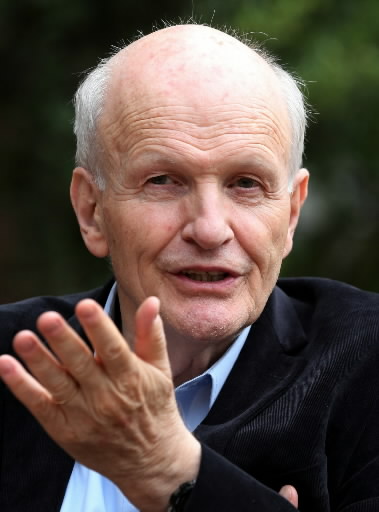Japan’s nuclear fuel cycle: Contribute to non-proliferation by abandoning reprocessing
Jun. 20, 2012
Interview with Prof. Frank von Hippel of Princeton University
by Yumi Kanazaki, Editorial Writer
With the disaster at the Fukushima No. 1 (Daiichi) nuclear power plant, the government has been reviewing the nuclear fuel cycle in which spent fuel is reprocessed and plutonium is extracted from it and reused. Princeton University Prof. Frank von Hippel, 74, who was involved in formulating nuclear non-proliferation policy during the administration of U.S. President Bill Clinton, asserts that the current policy must be thoroughly reviewed and that Japan should stop reprocessing spent nuclear fuel. The Chugoku Shimbun interviewed him during a visit to Japan in May. The following are excerpts from that interview.
Why are you critical of Japan’s reprocessing policy?
Even if it’s intended for civilian use, plutonium can be used to make nuclear weapons. As the number of nations that can reprocess it increases, there is also the risk that some countries will misuse the technology. That was the case with India, which conducted a nuclear test in 1974. In the past, countries such as Brazil and Argentina have conducted research into reprocessing while hiding the fact that it was for military purposes. Reprocessing undermines the nuclear non-proliferation regime and the prevention of nuclear terrorism.
Japan is the only non-nuclear–weapon state that has a commercial-scale reprocessing plant. Even if it’s not for military purposes, it runs counter to the current global trend.
Are Japan’s policies actually influencing other countries?
Yes, they have influenced South Korea, which is engaged in tough negotiating with the United States on revisions to their bilateral nuclear energy agreement. South Korea says they have only limited space in their storage pools for spent nuclear fuel and are pressuring the U.S. to permit reprocessing under the terms of the agreement, citing the example of Japan. In May I had a chance to discuss the matter with South Korean government officials. They strenuously maintained that it was strange for them not to have the same rights as Japan.
How do you think the negotiations between the U.S. and South Korea will go?
It’s hard to say. Of course, the U.S. is against the idea, but as long as Japan is reprocessing nuclear fuel there’s not much they can say. If South Korea changes course, there will certainly be a growing trend toward reprocessing. It’s possible that Iran may follow suit in the future.
In Japan, including Hiroshima, reprocessing has not been properly viewed as a problem that poses an obstacle to the abolition of nuclear weapons.
There are 250 tons of plutonium in the world being used for civilian purposes in addition to the plutonium that was separated out for military purposes during the Cold War by nations with nuclear weapons. Japan has a stockpile of 45 tons of plutonium, including that being stored in the United Kingdom and France for reprocessing there. That is more than 5,000 times the amount used in the atomic bomb dropped on Nagasaki. If the reprocessing plant under construction [in Rokkasho, Aomori Prefecture] goes into operation, even more plutonium will accumulate.
The Japanese government and industry say that reprocessing is a way to reduce the amount of radioactive waste.
If spent nuclear fuel is reprocessed and used to make mixed plutonium-uranium oxide fuel (MOX), it’s true that the volume of radioactive waste will decline. But the heat output from the spent MOX fuel is several times greater than that of uranium fuel. The disposal sites have to be spread out. And when you consider the difficulty of handling the fuel, the tremendous cost of reprocessing and the issue of nuclear proliferation, there’s no real advantage.
Some people have said that in order to keep the fuel pools at nuclear power plants from filling up with spent nuclear fuel, the fuel must be taken to reprocessing plants.
The high density of fuel storage pools can be lowered dramatically with methods to enhance safety. The way to do it is to have an interim storage facility on the premises of the nuclear power plant that cools using air instead of water. It’s dry cask storage. While storing the material temporarily, the location and technology for a final disposal site deep underground where spent nuclear fuel can be taken should be studied. Even if fuel is reprocessed, a final disposal site is necessary.
Are there dry cask storage facilities in Japan?
As a matter of fact, there is one at the Fukushima No. 1 nuclear power plant. It survived the disaster last year, but the fuel pool at the No. 4 reactor sustained catastrophic damage. Now is the time for Japan to adopt dry cask storage at all of its nuclear power plants.
What is the key to Japan’s abandonment of reprocessing?
The government has made reprocessing an essential element of its nuclear energy policy, but other countries use nuclear power without reprocessing plants or fast-breeder reactors. The problem is the political obstacles. It may take courage to change policies that have been developed over the years.
Leaving things up to the “nuclear village” is difficult. This summer, in a reconsideration of its past energy policy, the Japanese government is preparing to come up with a future energy policy plan that includes its nuclear fuel cycle policy. There needs to be open, public debate on the issue.
Frank von Hippel
Born in Massachusetts. Earned a doctorate in theoretical physics from Oxford University in England. Served as Assistant Director for National Security in the White House Office of Science and Technology Policy from 1993 to 1994 during the Clinton administration. Serves as co-chair of the International Panel on Fissile Materials, a group of independent nuclear experts from 16 countries. Offers advice on strengthening measures for nuclear disarmament and non-proliferation. His grandfather, James Franck, participated in the Manhattan Project after winning the Nobel Prize in physics and recommended against dropping the atomic bomb without warning.
(Originally published on June 13, 2012)








